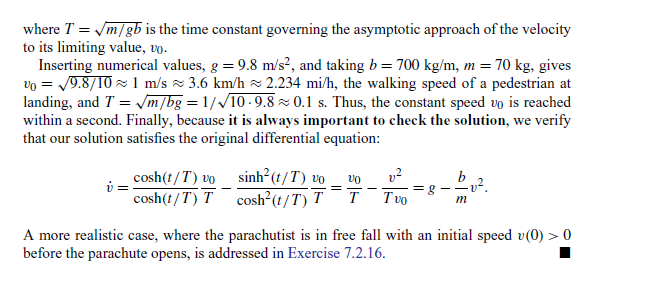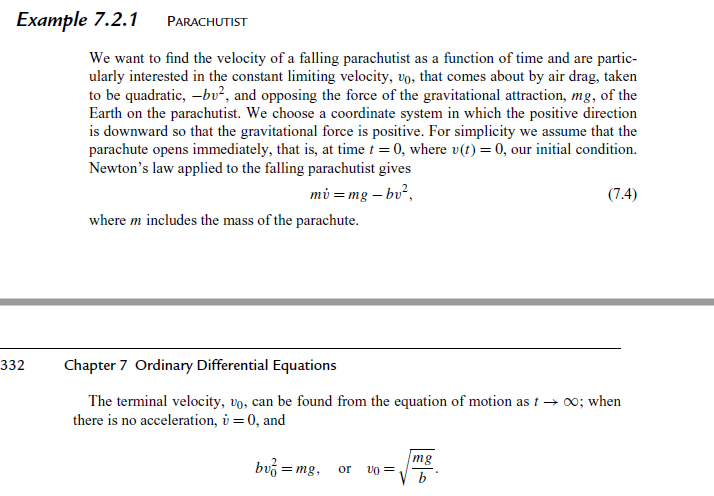Home /
Expert Answers /
Advanced Physics /
mathematical-methods-for-physicists-solve-in-detail-a-solve-example-pa311
(Solved): mathematical methods for physicists solve in detail (a) Solve Example ...
mathematical methods for physicists
solve in detail

(a) Solve Example 7.2.1, assuming that the parachute opens when the parachutist's velocity has reached \( v_{i}=60 \mathrm{mi} / \mathrm{h} \) (regard this time as \( t=0 \) ). Find \( v(t) \). (b) For a skydiver in free fall use the friction coefficient \( b=0.25 \mathrm{~kg} / \mathrm{m} \) and mass \( m=70 \mathrm{~kg} \). What is the limiting velocity in this case?
We want to find the velocity of a falling parachutist as a function of time and are particularly interested in the constant limiting velocity, \( v_{0} \), that comes about by air drag, taken to be quadratic, \( -b v^{2} \), and opposing the force of the gravitational attraction, \( m g \), of the Earth on the parachutist. We choose a coordinate system in which the positive direction is downward so that the gravitational force is positive. For simplicity we assume that the parachute opens immediately, that is, at time \( t=0 \), where \( v(t)=0 \), our initial condition. Newton's law applied to the falling parachutist gives \[ m \dot{v}=m g-b v^{2}, \] where \( m \) includes the mass of the parachute. Chapter 7 Ordinary Differential Equations The terminal velocity, \( v_{0} \), can be found from the equation of motion as \( t \rightarrow \infty \); when there is no acceleration, \( \dot{v}=0 \), and \[ b v_{0}^{2}=m g, \quad \text { or } \quad v_{0}=\sqrt{\frac{m g}{b}} . \]
It simplifies further work to rewrite Eq. (7.4) as \[ \frac{m}{b} \dot{v}=v_{0}^{2}-v^{2} . \] This equation is separable, and we write it in the form \[ \frac{d v}{v_{0}^{2}-v^{2}}=\frac{b}{m} d t . \] Using partial fractions to write \[ \frac{1}{v_{0}^{2}-v^{2}}=\frac{1}{2 v_{0}}\left(\frac{1}{v+v_{0}}-\frac{1}{v-v_{0}}\right), \] it is straightforward to integrate both sides of Eq. (7.5) (the left-hand side from \( v=0 \) to \( v \), the right-hand side from \( t=0 \) to \( t \) ), yielding \[ \frac{1}{2 v_{0}} \ln \frac{v_{0}+v}{v_{0}-v}=\frac{b}{m} t . \] Solving for the velocity, we have \[ v=\frac{e^{2 t / T}-1}{e^{2 t / T}+1} v_{0}=v_{0} \frac{\sinh (t / T)}{\cosh (t / T)}=v_{0} \tanh \frac{t}{T}, \]
where \( T=\sqrt{m / g b} \) is the time constant governing the asymptotic approach of the velocity to its limiting value, \( v_{0} \). Inserting numerical values, \( g=9.8 \mathrm{~m} / \mathrm{s}^{2} \), and taking \( b=700 \mathrm{~kg} / \mathrm{m}, m=70 \mathrm{~kg} \), gives \( v_{0}=\sqrt{9.8 / 10} \approx 1 \mathrm{~m} / \mathrm{s} \approx 3.6 \mathrm{~km} / \mathrm{h} \approx 2.234 \mathrm{mi} / \mathrm{h} \), the walking speed of a pedestrian at landing, and \( T=\sqrt{m / b g}=1 / \sqrt{10 \cdot 9.8} \approx 0.1 \mathrm{~s} \). Thus, the constant speed \( v_{0} \) is reached within a second. Finally, because it is always important to check the solution, we verify that our solution satisfies the original differential equation: \[ \dot{v}=\frac{\cosh (t / T)}{\cosh (t / T)} \frac{v_{0}}{T}-\frac{\sinh ^{2}(t / T)}{\cosh ^{2}(t / T)} \frac{v_{0}}{T}=\frac{v_{0}}{T}-\frac{v^{2}}{T v_{0}}=g-\frac{b}{m} v^{2} . \] A more realistic case, where the parachutist is in free fall with an initial speed \( v(0)>0 \) before the parachute opens, is addressed in Exercise 7.2.16.


![It simplifies further work to rewrite Eq. (7.4) as
\[
\frac{m}{b} \dot{v}=v_{0}^{2}-v^{2} .
\]
This equation is separable, an](https://media.cheggcdn.com/media/c50/c5053cf6-7fc9-45c8-bef3-7c3caff13d4b/phpCm7Aj0)